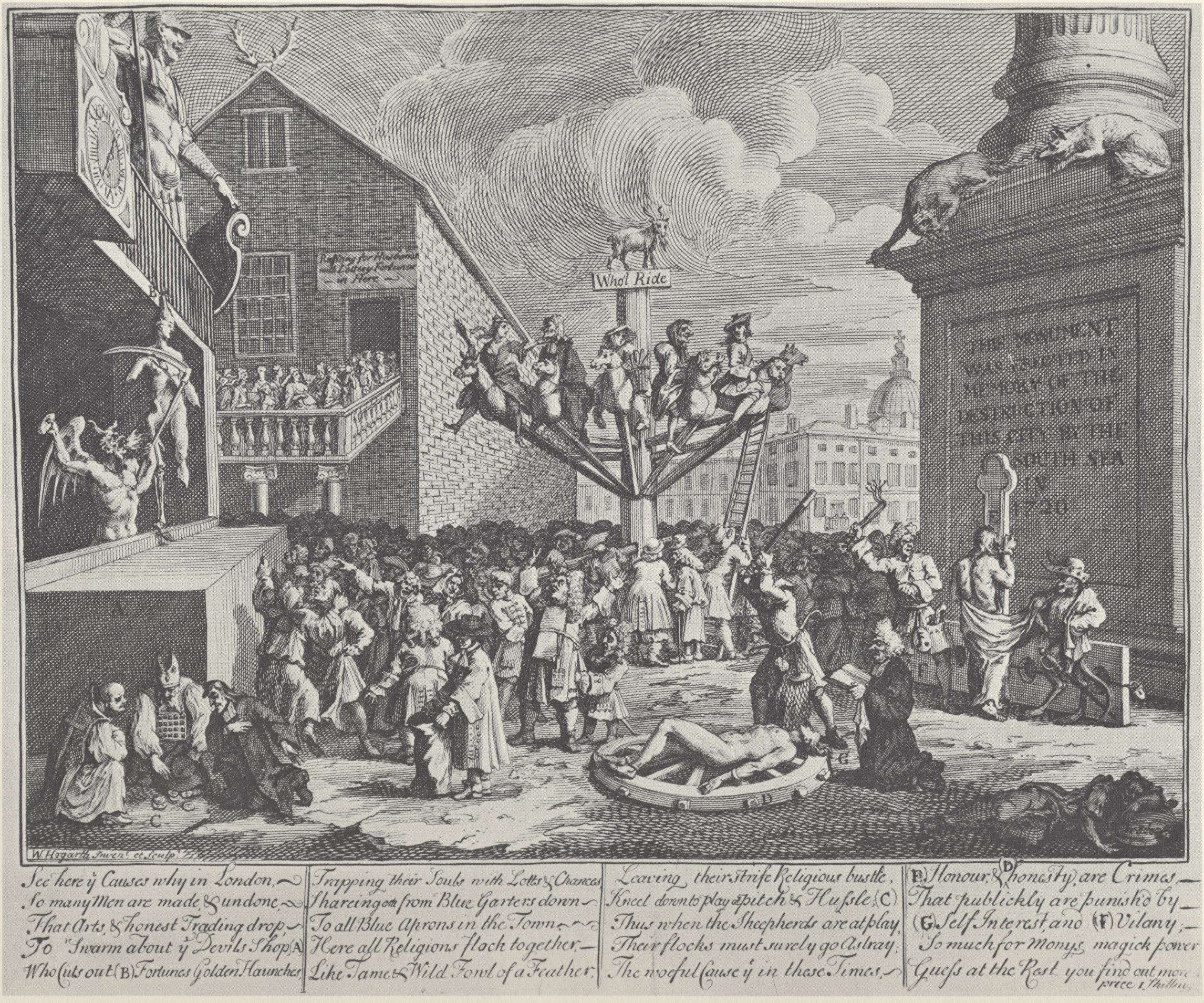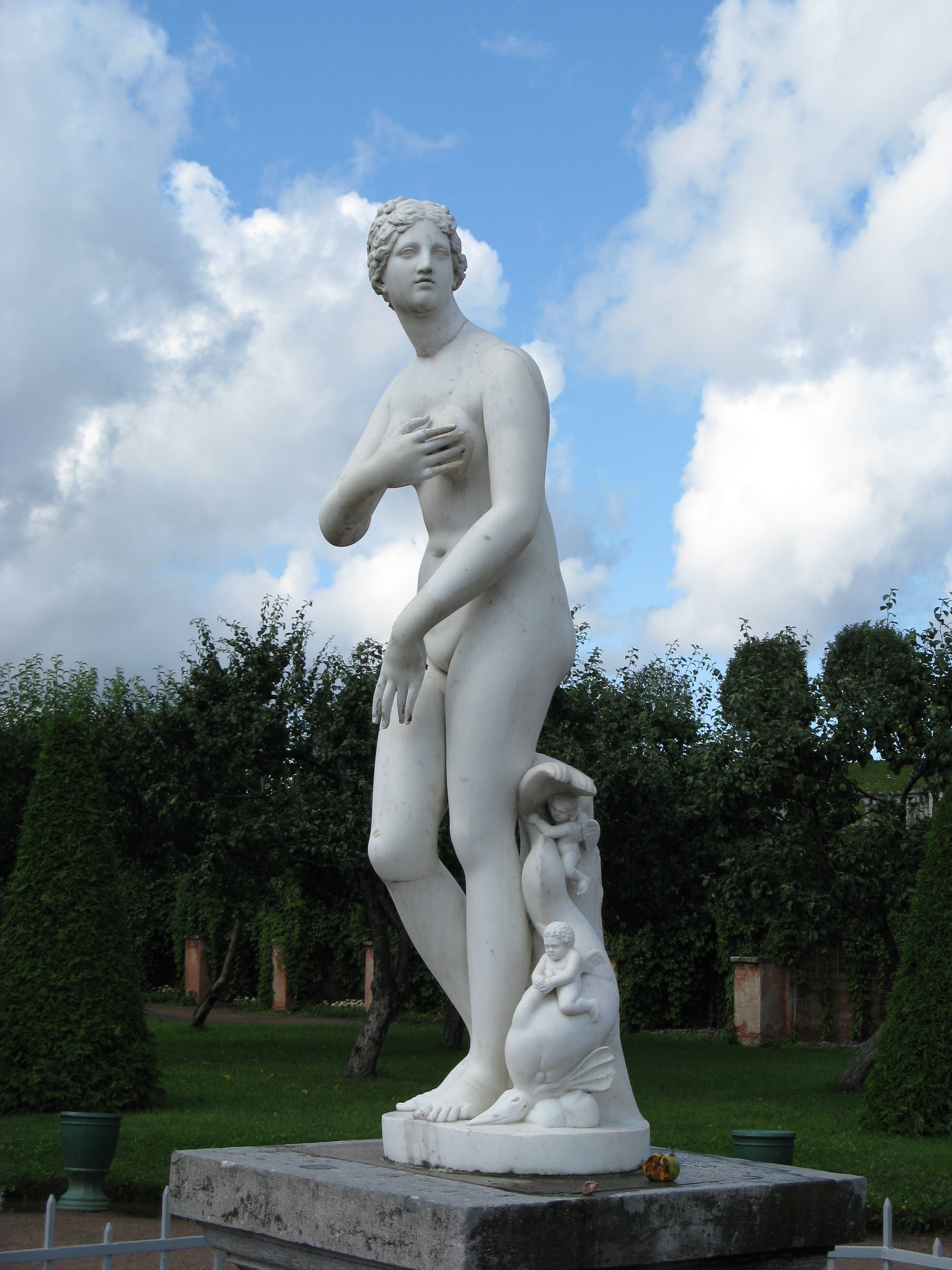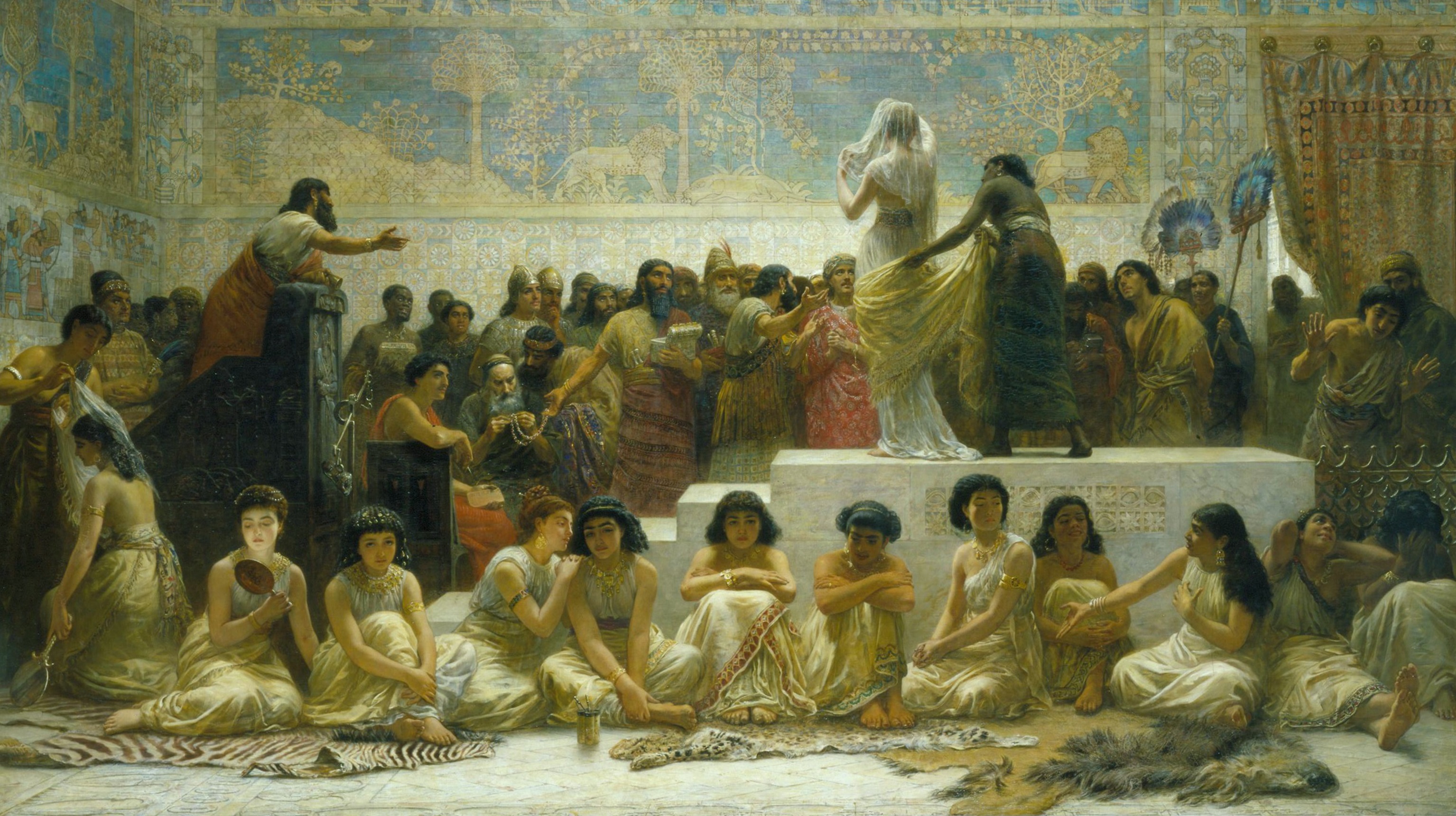|
Taste In High Life
''Taste in High Life'' is an oil-on-canvas painting (''engraving seen on the right'') from around 1742, by William Hogarth. The version seen on the right was engraved by Samuel Phillips in 1798, under commission from John Boydell for a posthumous edition of Hogarth's works, but Phillips's final, third state was not published until 1808. Analysis The work, a forerunner of '' Marriage à-la-mode'', was intended to satirise and poke fun at the types of dress and garbs that were in fashion at the time, and the superficiality of the tastes and nature of the aristocracy in general. Several figures are seen in the painting, all of whom are dressed in heavily caricatured renditions of the fashion that reigned in the 1740s. Most prominently exhibited is an elderly woman wearing a sacque covered with satirically overblown roses expanded by a large hoop. Standing near her is an opulently dressed man, thought to be "Beau" Colyear, 2nd Earl of Portmore (the dress he wears is said to be t ... [...More Info...] [...Related Items...] OR: [Wikipedia] [Google] [Baidu] |
William Hogarth
William Hogarth (; 10 November 1697 – 26 October 1764) was an English painter, engraver, pictorial satirist, social critic, editorial cartoonist and occasional writer on art. His work ranges from realistic portraiture to comic strip-like series of pictures called "modern moral subjects", and he is perhaps best known for his series ''A Harlot's Progress'', ''A Rake's Progress'' and '' Marriage A-la-Mode''. Knowledge of his work is so pervasive that satirical political illustrations in this style are often referred to as "Hogarthian". Hogarth was born in London to a lower-middle-class family. In his youth he took up an apprenticeship with an engraver, but did not complete the apprenticeship. His father underwent periods of mixed fortune, and was at one time imprisoned in lieu of outstanding debts, an event that is thought to have informed William's paintings and prints with a hard edge. Influenced by French and Italian painting and engraving, Hogarth's works are mostly sat ... [...More Info...] [...Related Items...] OR: [Wikipedia] [Google] [Baidu] |
Venus De' Medici
The Venus de' Medici or Medici Venus is a tall Hellenistic marble sculpture depicting the Greek goddess of love Aphrodite. It is a 1st-century BC marble copy, perhaps made in Athens, of a bronze original Greek sculpture, following the type of the Aphrodite of Knidos, which would have been made by a sculptor in the immediate Praxitelean tradition, perhaps at the end of the century. It has become one of the navigation points by which the progress of the Western classical tradition is traced, the references to it outline the changes of taste and the process of classical scholarship. It is housed in the Uffizi Gallery, Florence, Italy. Origin The statue depicts the goddess in a fugitive, momentary pose, as if surprised in the act of emerging from the sea, to which the dolphin at her feet alludes. The dolphin would not have been a necessary support for the bronze original. The statue base bears the Greek inscription ΚΛΕΟΜΕΝΗΣ ΑΠΟΛΛΟΔΩΡΟΥ ΑΘΗΝΑΙΟΣ ΕΠΩ ... [...More Info...] [...Related Items...] OR: [Wikipedia] [Google] [Baidu] |
List Of Works By William Hogarth
This is a list of works by William Hogarth by publication date (if known). As a printmaker Hogarth often employed other engravers to produce his work and frequently revised his works between one print run and the next, so it is often difficult to accurately differentiate between works by (or for) Hogarth and those in the style of or "after". Some of the less likely, possible, doubtful works and those formerly identified as Hogarth's works are listed at the end. Numbers in square brackets refer to the catalogue numbers in Ronald Paulson's third edition of ''Hogarth's Graphic Works'' (those with asterisks are classified as "After Hogarth" by Paulson). The works are all paintings, prints or drawings, apart from Hogarth's 1753 book ''The Analysis of Beauty''. 1720s *Tatton Coat of Arms (early) *Benefit ticket for Spiller (1720?) *Shop card (1720)—advertising Hogarth's own engraving shop *Shop card for Hardy (early) *Funeral ticket (c.1721-36) 2*Shop card for Ellis Gamble (c. ... [...More Info...] [...Related Items...] OR: [Wikipedia] [Google] [Baidu] |
Guinea (British Coin)
The guinea (; commonly abbreviated gn., or gns. in plural) was a coin, minted in Great Britain between 1663 and 1814, that contained approximately one-quarter of an ounce of gold. The name came from the Guinea region in West Africa, from where much of the gold used to make the coins was sourced. It was the first English machine-struck gold coin, originally representing a value of 20 shillings in sterling specie, equal to one pound, but rises in the price of gold relative to silver caused the value of the guinea to increase, at times to as high as thirty shillings. From 1717 to 1816, its value was officially fixed at twenty-one shillings. In the Great Recoinage of 1816, the guinea was demonetised and the word "guinea" became a colloquial or specialised term. Although the coin itself no longer circulated, the term ''guinea'' survived as a unit of account in some fields. Notable usages included professional fees (medical, legal, etc.), which were often invoiced in guineas, and h ... [...More Info...] [...Related Items...] OR: [Wikipedia] [Google] [Baidu] |
Revenge
Revenge is committing a harmful action against a person or group in response to a grievance, be it real or perceived. Francis Bacon described revenge as a kind of "wild justice" that "does... offend the law ndputteth the law out of office." Primitive justice or retributive justice is often differentiated from more formal and refined forms of justice such as distributive justice and divine judgment. Function in society Social psychologist Ian Mckee states that the desire for the sustenance of power motivates vengeful behavior as a means of impression management: "People who are more vengeful tend to be those who are motivated by power, by authority and by the desire for status. They don't want to lose face". Vengeful behavior has been found across a majority of human societies. Some societies encourage vengeful behavior, which is called a feud. These societies usually regard the honor of individuals and groups as of central importance. Thus, while protecting of their reputa ... [...More Info...] [...Related Items...] OR: [Wikipedia] [Google] [Baidu] |
Profligate
A spendthrift (also profligate or prodigal) is someone who is extravagant and recklessly wasteful with money, often to a point where the spending climbs well beyond his or her means. "Spendthrift" derives from an obsolete sense of the word "thrift" to mean prosperity rather than frugality, so a "spendthrift" is one who has spent their prosperity. Historical figures who have been characterised as spendthrifts include George IV of the United Kingdom, King Ludwig II of Bavaria, and Marie Antoinette the Queen of France. The term is often used by news media as an adjective applied to governments who are thought to be wasting public money. Etymology While the pair of words may seem to imply the opposite of its meaning (as if you are thrifty in your spending), it follows the tradition of the earlier word "scattergood", the first part being an undoing of the second. In artwork William Hogarth's ''A Rake's Progress'' (1732–33) displays in a series of paintings the spiralling fortune ... [...More Info...] [...Related Items...] OR: [Wikipedia] [Google] [Baidu] |
Lord Anne Hamilton
Lord Anne Hamilton (12 October 1709 – 25 December 1748) was a Scottish nobleman. He is said to have married the richest woman in the UK and they had a child. Early life Hamilton was born at St. James's Square, London, the third son of Lieutenant-General James Hamilton, 4th Duke of Hamilton, and his wife the Honourable Elizabeth Gerard, daughter of Digby Gerard, 5th Baron Gerard. His feminine forename is due to his being named after his godmother, Queen Anne. Hamilton's other godparents were John Churchill, 1st Duke of Marlborough and Charles Spencer, 3rd Earl of Sunderland. Hamilton was commissioned into the Coldstream Guards as an ensign on 4 April 1731, and resigned in May 1733. Personal life and death 260px, "Edwards Hamilton family on a Terrace", 1734 by William Hogarth Lord Anne Hamilton reputedly married Mary Edwards, in or before 1731, in a clandestine marriage said to have been in the chapel of the Fleet Prison. It was reported in The Gentleman's Magazine but th ... [...More Info...] [...Related Items...] OR: [Wikipedia] [Google] [Baidu] |
Mary Edwards (1705–1743)
Mary Edwards of Kensington (1704 – 23 August 1743) was an English heiress and art patron who was said to be the richest woman in England. She reportedly married but later tried to remove any evidence of the ceremony. She lived with Lord Anne Hamilton for several years and they had a child, but he married again, without a divorce. Life Edwards was probably born in London in about 1704 or 1705. Her mother came from the Dutch family who had drained the fens and her father, Francis Edwards (''d''. 1729), a member of the landed gentry, owned lands in Leicestershire, Northamptonshire, London & Middlesex, Essex, Hertfordshire and Kent and he had shares in the New River Company in Islington. Her father died in 1729 and as there was no will then his riches would be left to his widow and her mother Anna Margaretta Vernatti. However her mother renounced her claim and passed on the estate to Mary. Her fortune at the age of about 23 was estimated to be between £50,000 and £60,000 (about � ... [...More Info...] [...Related Items...] OR: [Wikipedia] [Google] [Baidu] |
Beer Street And Gin Lane
''Beer Street'' and ''Gin Lane'' are two prints issued in 1751 by English artist William Hogarth in support of what would become the Gin Act. Designed to be viewed alongside each other, they depict the evils of the consumption of gin as a contrast to the merits of drinking beer. At almost the same time and on the same subject, Hogarth's friend Henry Fielding published ''An Inquiry into the Late Increase in Robbers''. Issued together with ''The Four Stages of Cruelty'', the prints continued a movement started in ''Industry and Idleness'', away from depicting the laughable foibles of fashionable society (as he had done with '' Marriage A-la-Mode'') and towards a more cutting satire on the problems of poverty and crime. On the simplest level, Hogarth portrays the inhabitants of Beer Street as happy and healthy, nourished by the native English ale, and those who live in Gin Lane as destroyed by their addiction to the foreign spirit of gin; but, as with so many of Hogarth's works, ... [...More Info...] [...Related Items...] OR: [Wikipedia] [Google] [Baidu] |
Sedan Chair
The litter is a class of wheelless vehicles, a type of human-powered transport, for the transport of people. Smaller litters may take the form of open chairs or beds carried by two or more carriers, some being enclosed for protection from the elements. Larger litters, for example those of the Chinese emperors, may resemble small rooms upon a platform borne upon the shoulders of a dozen or more people. To most efficiently carry a litter, porters either place the carrying poles directly upon their shoulders or use a yoke to transfer the load from the carrying poles to the shoulders. Definitions A simple litter consists of a sling attached along its length to poles or stretched inside a frame. The poles or frame are carried by porters in front and behind. Such simple litters are common on battlefields and emergency situations, where terrain prohibits wheeled vehicles from carrying away the dead and wounded. Litters can also be created quickly by the lashing of poles to a chair ... [...More Info...] [...Related Items...] OR: [Wikipedia] [Google] [Baidu] |
Auction
An auction is usually a process of buying and selling goods or services by offering them up for bids, taking bids, and then selling the item to the highest bidder or buying the item from the lowest bidder. Some exceptions to this definition exist and are described in the section about different types. The branch of economic theory dealing with auction types and participants' behavior in auctions is called auction theory. The open ascending price auction is arguably the most common form of auction and has been used throughout history. Participants bid openly against one another, with each subsequent bid being higher than the previous bid. An auctioneer may announce prices, while bidders submit bids vocally or electronically. Auctions are applied for trade in diverse contexts. These contexts include antiques, paintings, rare collectibles, expensive wines, commodities, livestock, radio spectrum, used cars, real estate, online advertising, vacation packages, emission trading, a ... [...More Info...] [...Related Items...] OR: [Wikipedia] [Google] [Baidu] |
Oil-on-canvas
Oil painting is the process of painting with pigments with a medium of drying oil as the binder. It has been the most common technique for artistic painting on wood panel or canvas for several centuries, spreading from Europe to the rest of the world. The advantages of oil for painting images include "greater flexibility, richer and denser colour, the use of layers, and a wider range from light to dark". But the process is slower, especially when one layer of paint needs to be allowed to dry before another is applied. The oldest known oil paintings were created by Buddhist artists in Afghanistan and date back to the 7th century AD. The technique of binding pigments in oil was later brought to Europe in the 15th century, about 900 years later. The adoption of oil paint by Europeans began with Early Netherlandish painting in Northern Europe, and by the height of the Renaissance, oil painting techniques had almost completely replaced the use of tempera paints in the majority ... [...More Info...] [...Related Items...] OR: [Wikipedia] [Google] [Baidu] |









